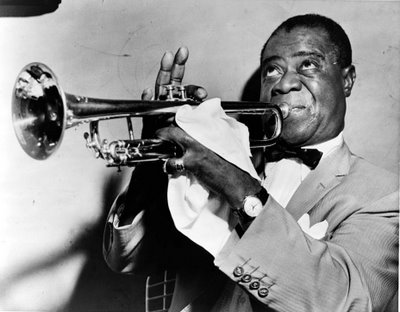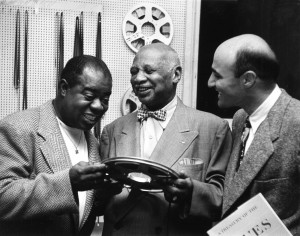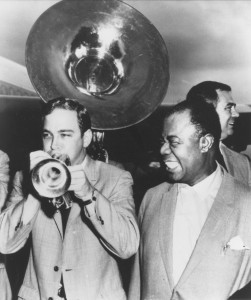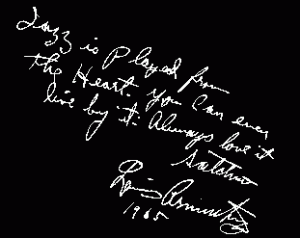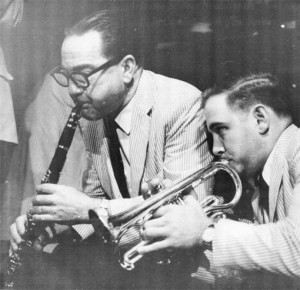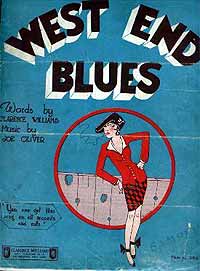As befits a legend, Louis Armstrong had two birthdays. He always said with a smile that he was born on the 4th of July, 1900. His baptismal birth certificate gave another, less romantic date—August 4, 1901. Honoring 'the man who taught the world to swing,' this week we hear from people who knew and worked with him, listen to historic recordings and new performances by The Jim Cullum Jazz Band.
Among those we hear are record producer George Avakian, Metropolitan Opera star Robert Merrill, former Armstrong All-Star Peanuts Hucko and Roger Glenn, son of his trombonist Tyree Glenn.
Over the decades visitors to The Landing in San Antonio couldn't miss a five-foot-high photo of a youthful Jim Cullum blowing his cornet, standing next to an admiring Louis Armstrong. Taken in 1965 at the San Antonio airport, Armstrong had arrived to play a concert gig in town, when Jim, along with his father and their Band, rolled out the red carpet and hot jazz for Louis. Next to the airport shot hung a reproduction of the famous Louis Armstrong quote heard at the end of every Riverwalk Jazz broadcast, "Jazz is played from the heart. You can even live by it. Always love it."—Satchmo Louis Armstrong, 1965.
In the 21st century Armstrong's identity as the single most important innovator in the history of jazz is hidden by the mask of his continuing pop stardom. Not long ago his instantly recognizable voice was heard on the sound track of a national TV commercial, a brief fragment of his "Give Me a Kiss to Build a Dream On." On cable TV one can still view the eleven feature-length films in which he appeared, including The Five Pennies with Danny Kaye; High Society with Grace Kelly, Frank Sinatra and Bing Crosby; and Hello Dolly with Barbra Streisand.
The story of Armstrong's fame tracks the story of jazz itself. Building on the work of his New Orleans mentor, King Oliver, Louis began to attract widespread attention with his Hot Five and Hot Seven recordings made in 1920s' Chicago. There was an important stint with the Fletcher Henderson Orchestra in New York in 1924, after which his deep influence on New York jazz musicians can be heard. The entire Swing Era of the 1930s would be unthinkable without the rhythmically advanced, bravura solo style that Louis invented and documented a decade earlier in Chicago.
Stanley Crouch, writing in the March 12, 2000 New York Times: "[Armstrong] was a figure of such grand influence that we cannot always be sure that we are actually assessing him accurately. Just when we think we have some idea of how profoundly he shaped the rhythms, nuances, and harmonies of American music, a television commercial advertising an Elvis Presley collection of Christmas songs will come on and, right there, Armstrong will push his jubilant beat through the mouth of the rock star. The sensational Savion Glover will be dancing and a phrase deeply beholden to Armstrong will arrive as this young master taps out his percussive music against the floor."
The bright light of Louis' genius lit up the far corners of America's musical landscape in the 1930s, when Jim Cullum's father, Jim Sr., was growing up in Dallas. Jim says, "Louis had a deep impact upon my father one summer day in 1931. As a budding 16-year-old clarinetist, he was taken by the hand by several older musicians to listen to a wind-up Victrola pump out Armstrong's "When You're Smiling." It was a moment of epiphany. Life was never the same and Dad set out obsessed to acquire every Armstrong recording."
Jim Cullum continues, "As things went along, Dad was driven to become a professional clarinetist/saxophonist. Later, as a member of the Jack Teagarden Orchestra, he, along with Jack, had opportunities to jam with Armstrong in after-hours sessions at a St. Louis 'black and tan' club—it was a great thrill for him."
Ann Douglas, writing in Terrible Honesty: Mongrel Manhattan in the 1920s, writes about the feeling one gets from listening to Armstrong's trumpet:
"Armstrong's brand of jazz was complex, of course; his masterpiece, "West End Blues," recorded in 1928 with Earl Hines on piano, is as hard to imitate as any later, self-consciously difficult jazz, and Armstrong never denied the physical work his performance involved...But whatever the artistic complexities involved, whatever the effort, even pain of performance, his aim was always to free the listener from worry and trouble…"
It is "West End Blues," as well as a host of other "hidden" Armstrong masterworks, that Jim Cullum chooses to present to Landing audiences every night and on the radio every week. Louis Armstrong thought of himself as an entertainer very much in the mainstream of "show business." He wrote,
"I never tried to prove nothing, just always wanted to give a good show. My life has been my music; it's always come first, but the music ain't worth nothing if you can't lay it on the public. The main thing is to live for that audience, 'cause what you're there for is to please the people."
We're forced to confront Louis' desire to please his audience, not only to explain the sentimental "What a Wonderful World," one of his best known works today—but the high-octane solo trumpet flight of "West End Blues" as well. Each work, though very different and produced over 40 years apart, provides a direct, authentic emotional connection to Louis himself.
These are the qualities which suffuse all of Louis Armstrong's recorded work, in whatever medium he appears, more than a century after his birth. The growing number of jazz fans who never saw Louis Armstrong perform live may encounter him today in one of his several guises—pioneering trumpet player, singer, movie actor, songwriter, author, and pop-culture icon. Louis Armstrong's message, the joy and warmth of his rhythm, still goes straight to our hearts.
Photo credit for Home Page: Louis Armstrong photo courtesy songbook1.wordpress.
Text based on Riverwalk Jazz script by Margaret Moos Pick ©2011 & essay by Don Mopsick


